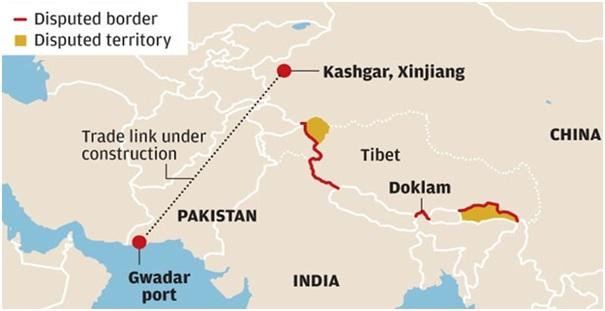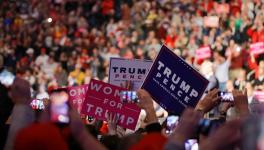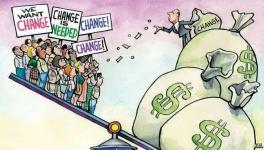BRICS Xiamen Summit Doomed by Centrifugal Economics

Newsclick Image by Nitesh Kumar
The Brazil-Russia-India-China-South Africa summit in Xiamen from September 3-5 is already inscribed with high tension thanks to Sino-Indian border conflicts. But regardless of a new peace deal, centrifugal forces within the fast-whirling world economy threaten to divide the BRICS.
Beijing’s logo designers for this summit, perhaps unconsciously subversive, illustrated how the formerly overlapping, interlocking BRICS are now thin and flimsy, wedging themselves apart. Such a prospect was predictable earlier this year as a result of Donald Trump’s ascendance. Both Washington’s neo-conservative ‘Deep State‘ and the (fast-disappearing) paleo-conservatives were intent on ramping up conflict with China – though early on, BRICS splintering towards the US included not only proto-fascist India, for elites in Russia and Brazil also sought friendly relations.
A deeper reason for pessimism is that at the 2015 BRICS summit in Russia, just as world commodity markets began to collapse, Chinese premier Xi Jinping invoked the laws of physics. He asked fellow leaders “to boost the centripetal force of BRICS nations, tap their respective advantages and potentials and carry out cooperation in innovation and production capacity to boost competitiveness.” That’s the bloc’s theory – but practices are very different.

India fights China leaving BRICS as collateral damage
The most obvious geopolitical wedges are actually not Washington’s (for now), but instead Sino-Indian border conflicts. The most intractable is in Pakistani-held Kashmir, and concerns transport infrastructure needed by China to link its far western region to the sea.
A higher-profile fight unfolded over recent weeks where India and China share a border with Bhutan. When the Chinese built a small road on contested ground, fisticuffs were initiated by Indian soldiers. On Monday, India backed down and withdrew its troops, fortunately, but not before prime minister Narendra Modi’s staff hinted he would boycott Xiamen just as he had China’s Belt and Road Summit in May.
One analyst, Zhao Gancheng of the Shanghai Institute for International Studies, told the Australian Financial Review, “The BRICS summit is the immediate reason for this disengagement announcement. If there is a serious confrontation between China and India, the major members of BRICS, it doesn’t look good for either country. This is an important meeting for China, which is hosting the summit and Modi is expected to attend.”
Modi also lost a similar show-down when hosting the Goa 2016 BRICS Summit, trying unsuccessfully to have Pakistan declared a terrorist state; China and Russia refused. The Chinese state mouthpiece Global Times ran a column last week headined, “New Delhi may disrupt BRICS Summit to blackmail Beijing.” In part, such renewed Chinese nationalist posturing is useful ahead of the coming National Congress of the Communist Party where Xi aims to consolidate power.
For example, even before last Friday’s outbreak of mob violence that left 36 dead in Punjab (caused when a close Modi ally – religious guru Ram Rahim Singh – was convicted of rape), Beijing had just issued its second travel advisory within six weeks to its citizens visiting India: “Pay close attention to the local security situation, improve self-protection awareness, strengthen security and reduce unnecessary travel.” It’s the very opposite of the BRICS’ stated objective last month: “increasing people-to-people links.”
But more durably, the Sino-Indian regional geopolitical turf battle also reflects the ungluing of economic globalisation, insofar as China is desperate to expand trade and investment opportunities to the south and west. Earlier this month at the Quanzhou Governance Seminar, participants “paid little attention to the ongoing India-China military stand-off,” complained Sudheendra Kulkarni, who chairs the (pro-BRICS) Observer Research Foundation of Mumbai. Kulkanri worried that the bloc’s “very credibility would be called into question if our two countries allowed the dispute to be escalated into an armed conflict. Obviously, the Chinese hosts did not want a divisive bilateral issue to get any kind of focus in the midst of deliberations at a BRICS seminar.”
Censorship, spying and repression
In this context, the BRICS Think Tank, Academic Forum, Civil BRICS, BRICS Trade Union Forum and BRICS Youth initiatives have drawn more than a thousand well-mannered scholars and civilised-society leaders to China over the past few months. But like the Quanzhou meeting, another revealing ethical-intellectual dilemma emerged in June in Fuzhou. There, the director of the Society for the Participatory Research in Asia, Kaustuv Kanti Bandyopadhyay, concluded that the main BRICS-from-the-middle conference was “mere symbolism.” BRICS visitors “had no dialogue or exchange within China, or between countries before meeting in Fuzhou. Understandably, in the absence such dialogues before, during and after the Forum, it is unrealistic to expect that civil society organisations will come up with any specific policy ask from their leaders when they meet in September.”
Reflecting the way such personnel typically toe the party line, the Fuzhou declaration failed to remark upon widespread repression and worsening austerity across the BRICS, often in the name of improved economic competitiveness. In contrast, explained Hindu newspaper commentator Anul Aneja, “political parties, think tanks and civil society organisations of the BRICS grouping counseled emerging economies to lead a new wave of globalisation, and step up the fight against international terrorism.”
Such cheerleading echoes Washington’s traditional (pre-Trump) fusion of neo-liberalism and neo-conservatism, and also reflects Beijing’s worries about potential disruption to world trade, what with Brexit, Trump and high-profile trade deal cancellations. But beyond the economic deglobalisation threat, another Fuzhou Initiative statement by the academics and NGO staff is especially chilling: “BRICS countries should also increase cooperation in cyber security and promote the development of Internet technologies and the governance of cyberspace globally.”
Ominously, such intra-BRICS spymaster collaboration is already underway. To be sure, global surveillance by the US National Security Agency and web manipulation by Google to direct traffic away from progressive websites also appear to be worsening, with Trump’s regime downplaying civil liberties at every opportunity.
But fighting fire with fire won’t work, because not only is the record of the Chinese and Russian states in this area utterly invasive, they joined even India and South Africa last year to vote against the main United Nations resolution on protection of human rights and privacy on the internet, a resolution co-authored by Brazil and co-sponsored by 70 other countries. (Even by far the world’s most totalitarian surveillance regime, the United States under Barack Obama, was shamed into supporting the resolution.)
Beijing’s reputation for intellectual censorship is peaking, after widespread protest forced Cambridge University Press to reverse itself, having removed 300 articles about China from its website there last week. The world’s main social media services are banned, and top Chinese scientists complain about their need to use Apple apps to bypass state internet restrictions on even scientific, academic and United Nations websites. Late last month, Apple surrendered to Beijing’s demand to cancel that service.
Social justice activists face even tougher restrictions: for example, The Feminist Voice in China was booted off the country’s Twitter-equivalent in February after merely posting an anti-Trump article from The Guardian.
In South Africa, which (mainly as a result of sustained uncivil-society protest) is the most open of the five BRICS, State Security Minister David Mahlobo is widely condemned for snooping. Last week came revelations about his tapping what are likely in excess of 150 000 cellphone accounts. As the leading watchdog group Right 2 Know put it when fighting Mahlobo’s proposed intervention into social media a few weeks ago, “Giving State Security any role in ‘regulation’ is a sure path to internet censorship.”
Mahlobo’s party, the African National Congress (ANC) has ruled since Nelson Mandela’s presidency began in 1994 and is widely credited with ending apartheid. But after a multiply-dubious $5 billion arms deal and the rise of Jacob Zuma to its leadership in 2007, the ANC is now notorious for corruption. A “black ops war room“ last year generated fake news and bogus Twitter accounts against the ANC’s political opponents during a disastrous election campaign (it lost four of the five largest metro areas), before being exposed after failing to pay an IT consultant, who took the ANC to court.
Dirty tricks and repression are becoming the watchwords of regimes that need to keep a lid on dissent. In Hong Kong last week, 20-year old Umbrella Movement leader Joshua Wong and his allies Alex Chow and Nathan Law were jailed (for eight months) after state prosecution for the massive 2014 peaceful uprising. Tens of thousands protested in solidarity last Sunday, so there’s no question as to the democrats’ durability.
Economic stresses from over-production to deglobalisation
Indeed, two days before the BRICS meet in Xiamen, a Hong Kong People’s Forum will be convened by the Confederation of Trade Unions, Borderless Movement Editorial Board, Globalization Monitor, the Catholic Diocese’s Justice and Peace Commission, the Labor Education Support Network and the Neighborhood and Workers’ Service Centre’s Labor Committee. This follows the critical counter-summit traditions of brics-from-below in Durban, 2013; the BRICS Dialogue on Development in Fortaleza, 2014; and the People’s Forum on BRICS in Goa, 2016. (Russia was too repressed to try a counter-summit in 2015.)
As the Hong Kong People’s Forum argues, “Instead of offering an alternative, the BRICS actually offer a continuation to neo-liberalism. On top of BRICS there is also China’s new mega project, the Belt and Road initiative whose main purpose is to export China’s surplus capital, and in this process seek the cooperation and ‘mutual benefit’ of big foreign TNCs and regimes which are often authoritarian. The price of these investments is often borne by the working people and the ecological balance.”
Last week’s International Monetary Fund report confirmed China’s underlying capitalist crisis tendencies of over-production and over-indebtedness. Excess capacity levels had reached more than 30% in coal, non-ferrous metals, cement and chemicals by 2015 (in each, China is responsible for 45-60% of the world market). Chinese banks’ high-risk ratio rose from 4% in 2010 to more than 12% since early 2015. The Guardian’s Larry Elliott summed up IMF concerns over “methods used to keep the economy expanding rapidly: an increase in government spending to fund infrastructure programmes and a willingness to allow state-controlled banks to lend more for speculative property developments.”
The motors to expand capitalism rapidly – in China and everywhere – were meant to be foreign investment, trade and finance: i.e., economic globalisation. But all are running out of steam, or even veering towards collapse in the case of debt. According to the World Bank, global trade peaked at 61% of world GDP in 2008, crashed to 52% the next year, rose back to 61% in 2012, and then fell back to 2015’s 58% (although there has been a minor upturn in merchandise trade in early 2017).
IMF data on Chinese over-production and over-indebtedness
Declining trade and cross-border financial assets as % of world GDP
Declining rates of corporate profits (BRICS at top and G7) and Foreign Direct Investment
Sources: World Bank and UNCTAD
The trade motor is sputtering in each of the BRICS, which from the early 1990s had raised their trade/GDP ratios by at least 10 points. But then,
- Russia peaked first at a 69% trade/GDP ratio in 1999, and then fell steadily to 45% by 2016,
- Brazil peaked at 30% in 2004 and is now down to 25%,
- China peaked at 66% in 2006 and plummeted to 36%,
- South Africa peaked in 2008 with 73% and is now 60%, and
- India peaked last, in 2012 with 56%, and is now down to 40%.
As further evidence of economic deglobalisation’s centrifugal force, cross-border financial assets fell from 58% of world GDP in 2008 to 38% in 2016, in spite of fast-rising flows into high-risk (high-return) emerging markets and notwithstanding soaring overall indebtedness. In June, the Institute of International Finance announced that global debt has reached $217 trillion (327% of world GDP), up from $86 trillion (246% of GDP) in 2002 and $149 billion (276%) in 2007. Since 2012, emerging markets led by China have been responsible for all the addition to net debt.
Yet until a very recent uptick from extremely low levels, since 2008 (and indeed since the late 1980s) the BRICS’ corporate profit rates dropped even faster than did those of western firms. That decline was one reason for the halving of relative global Foreign Direct Investment: from 3.7% of world GDP in 2008 to 1.7% in 2016. But the next recession – which HSBC, Citigroup and Morgan Stanley economists last week acknowledged is imminent due to vastly over-priced stock markets and unprecendented corporate indebtedness – will also confirm how capitalist optimists have become over-exposed locally, even as they lose appetite for global markets.
Centrifugal realities crowd out centripetal fantasies
The centrifugal forces ripping apart world capitalism – first globalising, now deglobalising – have been forcing the metabolism of economic cycles into ever more intense bursts of crises since the 1970s, and ever-higher levels of world debt and central banks’ loose-money strategies are unable to restore growth. Global uneven development gave the BRICS a huge opportunity once economic stagnation hit the US, Europe and Japan in the 1970s, after the investment wave of the 1980s-90s in Asia’s smaller Newly Industrialising Countries ebbed. By the early 2000s, Goldman Sachs predicted the BRICs would provide capitalism’s new motor force. As the Financial Times put it in 2010, these “building BRICs” would “change the economic order” by marshalling both their own raw resource production and manufacturing capacity to, in turn, achieve sufficient weight to reduce unfairness in world trade and finance.
Notwithstanding the centripetal capitalism Xi has hoped for, the centrifugal contradictions manifest in over-production, debt and deglobalisation may put an end to those fantasies. The only recent relief came from the Chinese state’s massive urban construction investments (leaving scores of near-empty cities) and the Indian service sector-led boom, but the other three BRICS suffered recessions once the 2015 commodity price crash hit home (with South Africa yet to emerge into positive GDP growth). Xi’s centripetal BRICS has become a centrifugal force spiralling out of control.
And as for changing the manifestly unfair global system, in late 2015 the BRICS simply grabbed three of Obama’s multilateral-deform batons: promoting the Paris Climate Accord because it is non-binding, unambitious and outlaws climate-debt lawsuits by victims of Western and BRICS emissions; amending the World Trade Organisation so as to phase out any semblance of food sovereignty; and shifting IMF voting shares to favour BRICS at the expense of poorer countries.
Explains the Hong Kong People’s Forum, “China has now evolved into a global engine promoting a neo-liberal agenda: from free trade agreements to corporate-led integration across borders. The 2017 World Economic Forum in Davos was one site where Xi clearly took the lead in promoting world corporate power, as Trump leads the US-UK retreat into crony-capitalist protectionism.”
The Brazilian government is no help, for as the Workers Party complained last week as its former leader Lula was convicted on an obvious petty corruption frame-up, “In the country of the coup, the big decisions are made in Washington and Wall Street, and the order given is to sell and loot Brazil.” They pointed to the 57 major privatisations now underway, social spending austerity and anti-labour legislation, at a time ‘President’ Michel Temer is approving corporate gold mining in an Amazonian state nature reserve the size of Denmark.
Moreover, at last month’s G20 summit in Hamburg, BRICS leaders were even more callous about the economic damage to poorer countries they are inflicting in alignment with the G7 (and especially the G1 – in failing to materially punish Trump for climate change, e.g. through a major new carbon tax called for again in May by even Joseph Stiglitz). Consider the epithets of three seasoned political economists who in the past firmly favoured the BRICS:
- The Third World Network’s Ravi Kanth complained, “For the first time, the Doha Development Agenda or the unresolved Doha issues were not even mentioned in the G20 leaders’ communique because of opposition from the United States as well as other major industrialised countries. China, India, Brazil, South Africa, and Indonesia who negotiated the Hamburg declaration along with their developed country counterparts seemed to have allowed the erasing of DDA” – i.e. what Kanth considers poorer countries’ balanced trade interests.
- Added Yash Tandon (former head of the South Centre), “At the G20 Hamburg meeting, Africa was officially represented by only one country – South Africa, which was obsequiously behaving like a neo-colony that it is.”
- The problem is even deeper than the BRICS’ alliances with the West against rest, according to the Filippino politician and leading intellectual Walden Bello: “the stagnation of the once dynamic centers of the global demand — the U.S., Europe, and the BRICS — has made this model obsolete. It was, in fact, the non-viability of this once successful model of rapid growth in current global circumstances that pushed China, under Hu Jintao and Wen Jiabao, away from an export-oriented path to a domestic demand-led strategy via a massive $585 billion stimulus program. They failed, and the reason for their failure is instructive. In fact, a set of powerful interests had congealed around the export-oriented model.”
Xi and other Chinese Communist leaders committed to pro-corporate globalisation are inevitably going to seek more geographical band-aids like the trillion-dollar-plus Belt and Road mega-infrastructure to raise manufactured exports and energy imports through a restructuring Eurasia. But the BRICS’ financial short-term fixes – massive debt and stock market speculation – continue, too, as stock markets bubble in South Africa (today 90% higher than in 2010), India (70%) and Russia (50%). China’s stock exchanges were in the same league, but just as the yuan was made an IMF-acceptable global currency reserve in 2015-16, the Chinese markets lost more than $5 trillion in two share bubble bursts. Capital fled the country, requiring a re-imposition of Beijing’s tough exchange controls.
In what often seems a different universe entirely, Zuma pronounced last month to his ANC policy conference, “the ANC is part of the global anti-imperialist movement. We are historically connected with the countries of the South and therefore South-South cooperation such as BRICS is primary for our movement.”
In reality, the centrifugal economic forces breaking up the bloc – growing ever stronger due to over-production, excessive debt and a deglobalising world economy – confirm the failure of Xi’s desired centripetal capitalism. As this process unfolds, expect yet more talk-left walk-right politics, as sub-imperialists try to pretend they’re anti-imperialists.
(Patrick Bond is co-editor of BRICS: An anti-capitalist critique and is professor of political economy at the University of the Witwatersrand in Johannesburg.)
Disclaimer: The views expressed here are the author's personal views, and do not necessarily represent the views of Newsclick.
Get the latest reports & analysis with people's perspective on Protests, movements & deep analytical videos, discussions of the current affairs in your Telegram app. Subscribe to NewsClick's Telegram channel & get Real-Time updates on stories, as they get published on our website.
























